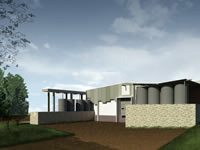 Fynbloem Builds export packing facility
Fynbloem Builds export packing facility
Going the extra mile in eco-friendly production
Fynbloem’s new packing facility in Riviersonderend Valley is a first of its kind export facility for Proteas.
Going against the grain the facility is designed to export the Proteas by sea freight rather than the more traditional airfreight.
A warehouse facility where the packing process takes place will be developed in 2 separate phases of approximately 3,000m2 each.
In addition, phase one will also accommodate a smaller public component which will house offices, meeting rooms and exhibition/display facilities of approximately 300m2. Should demand necessitate, the possibility of a third warehouse phase would be added in the future.
Natural cooling
The office component is located on the North Elevation in order to shield the northern face of the warehouse from sun as well as screening the warehouse itself from the public.
Cooling costs inside the warehouse, where a constant temperature of 10C˚ is crucial, can be cut down significantly in this manner.
The client has been in the process of clearing the farm of invasive tree species, Black Wattle, Port Jackson and Gum.
The timber recycled from this process will be used for the manufacture of screens which would sit on the north elevation which assist with passive solar control, thereby reducing the need for regular air-conditioning inside the office component. Plant waste generated by the pack house will be mulched and used for compost.
Rainwater harvesting
The roof surface will act as rainwater harvesters, discharging into rainwater tanks. The water would then be fed back into the building for personal consumption and hygiene .
Water used in the Protea packing process as well as grey and black water will be channelled to the dam where a reed bed filtration process will be used to treat and purify the water, after which the water will be fed back into the pack shed and, ultimately, be used to water the Proteas in the adjacent fields.
Energy saving
The roof structure over the main circulation corridor which not only acts as the major rainwater receiver but will also house the photo-voltaic panels which will be used to convert solar energy to electricity for use by the facility and, once fully implemented, would be able to supply excess electricity to the national grid.
Under-floor Insulation reduces the ingress of heat thereby reducing the cooling requirement while the most electrically efficient vacuum cooler is to be installed.
The introduction of solar domes allows for the ingress of natural light thereby reducing the need for artificial lighting while adjustable lighting levels enables manual regulation of electricity consumption. P5 light will be used for energy efficiency.
The C.O.P. of the mechanical plant used to cool the facility has been greatly enhanced by using a TAB system which effectively borrows the energy of the cooling plant to heat and cool the office spaces through the myriad of pipes running through its roof and floor slabs.
Addition energy savings are achieved by adding an outer metal jacket to the fireplace in the staff canteen. The void would contain and circulate water to the hot water cylinders. Firewood is obtained from the “Working for Water” program implemented on the farm to clear alien invasives.
Materials
Great care has been taken in selecting materials to be as sustainable and durable as possible. The natural stone was excavated on site, the sand used is from the farm, the bricks are from the closest possible source. Most of the materials used are left in their natural state, thus eliminating paint as far as possible.
The new facility has been built in response to the needs of FynBloem’s clients Marks & Spencer in the United Kingdom who have raised the bar for responsible production processes in the name of eco-friendly practises which reduce wastage, carbon footprint and ethical practises. This has been met ion more ways than one judging by the savings in use of lighting, the use of solar energy and recycled water to name a few.
While overall the use of sea freight will substantially reduce the carbon emission used in delivery of the Proteas.